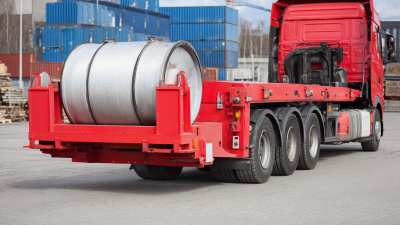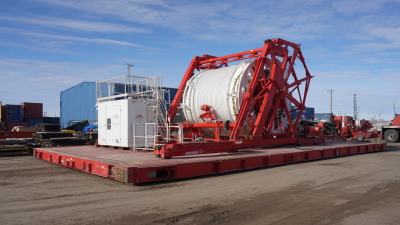How to Optimize Your Drum Tipper for Maximum Efficiency
In the modern manufacturing landscape, optimizing equipment for efficiency is paramount to maintaining competitive advantage.
 Drum tippers are integral to the handling and dispensing of materials, particularly in industries such as food processing, chemicals, and pharmaceuticals, where precision and safety are critical.
According to a recent report by the International Society for Automation, companies that implement optimized machinery, including drum tippers, can see productivity increases of up to 25% while reducing material waste by as much as 15%.
This optimization not only enhances workflow but also minimizes operational costs.
As industries continue to evolve toward automated and lean production methods, understanding how to maximize the efficiency of your drum tipper becomes essential for sustainable growth and profitability.
Drum tippers are integral to the handling and dispensing of materials, particularly in industries such as food processing, chemicals, and pharmaceuticals, where precision and safety are critical.
According to a recent report by the International Society for Automation, companies that implement optimized machinery, including drum tippers, can see productivity increases of up to 25% while reducing material waste by as much as 15%.
This optimization not only enhances workflow but also minimizes operational costs.
As industries continue to evolve toward automated and lean production methods, understanding how to maximize the efficiency of your drum tipper becomes essential for sustainable growth and profitability.
Understanding Drum Tipper Mechanics for Enhanced Performance
Understanding the mechanics of a drum tipper is crucial for enhancing its performance and achieving maximum efficiency in operations. A drum tipper typically relies on a combination of hydraulic systems, mechanical components, and control systems. By familiarizing yourself with how these elements work together, you can identify areas for improvement and maintenance. For instance, regular inspection of hydraulic fluid levels and ensuring the seals are in good condition can prevent leaks and improve the responsiveness of the tipping mechanism.
Additionally, the design of the drum tipper itself plays a significant role in its overall productivity. Ensuring that the tipping angles and weight distribution are optimized can reduce strain on the machine and extend its lifespan. Implementing features such as adjustable tipping heights or incorporating safety guards can further enhance usability and efficiency. Understanding the load capacity and utilizing ergonomic designs will ensure that operators can handle materials safely and efficiently, minimizing downtime and increasing throughput. By focusing on these mechanical aspects, you can maximize the operational efficiency of your drum tipper and enhance workplace productivity.
Drum Tipper Efficiency Optimization
This chart illustrates various performance metrics of drum tippers, highlighting the balance between weight capacity, speed, energy consumption, and operating cost. Optimizing these areas can lead to enhanced performance and efficiency in drum tipping operations.
Essential Maintenance Tips to Keep Your Drum Tipper Running Smoothly
Maintaining your drum tipper is essential for ensuring operational efficiency and preventing costly breakdowns. According to a recent report from the Material Handling Industry, nearly 25% of operational downtime can be attributed to equipment failure, much of which can be avoided through regular maintenance practices. To keep your drum tipper running smoothly, incorporating a routine inspection schedule is critical. Look for signs of wear in critical components like bearings and hydraulics, as these are often the first to show signs of fatigue.
Moreover, lubrication is a key aspect of drum tipper maintenance. The American Society of Mechanical Engineers states that proper lubrication can reduce friction and wear by up to 50%, prolonging the lifespan of your equipment. Ensure all moving parts are greased according to the manufacturer’s specifications and consider implementing an automatic lubrication system for consistent maintenance. By prioritizing these essential maintenance tips, you not only extend the life of your drum tipper but also optimize its efficiency, leading to increased productivity in your operations.
Choosing the Right Drum Tipper for Your Specific Operational Needs
When selecting the right drum tipper, it’s essential to consider the specific operational needs of your facility. Different industries may require varied capacities and functionalities. For instance, if your operation deals with heavy drums containing materials like chemicals or granules, a heavy-duty drum tipper that can handle higher weights and ensure safety during tipping is crucial. Look for features like adjustable height and automatic tipping controls which can significantly enhance productivity in environments where time-saving is paramount.
Additionally, consider the flexibility offered by various drum tippers. A model that accommodates different drum sizes and types will add value to your operation. Some tippers are designed for specific applications, such as those equipped with safety features that prevent accidental spills, making them ideal for handling hazardous materials. Take time to assess your workflow and the physical layout of your space to ensure the drum tipper you choose integrates seamlessly, contributing to efficiency and safety in your operations.

Adjusting Operational Techniques for Improved Drum Tipping Efficiency
 Optimizing operational techniques is essential for maximizing the efficiency of your drum tippers. One of the primary factors to consider is the angle and height of the drum during the tipping process. Adjustments in these parameters can significantly impact the ease with which materials flow from the drum. For instance, ensuring that the drum is tilted at an optimal angle not only aids in efficient unloading but also reduces the strain on the tipping mechanism, prolonging its lifespan. Regularly assessing the height of the drum can also help prevent unnecessary delays and improve the overall speed of operations.
Optimizing operational techniques is essential for maximizing the efficiency of your drum tippers. One of the primary factors to consider is the angle and height of the drum during the tipping process. Adjustments in these parameters can significantly impact the ease with which materials flow from the drum. For instance, ensuring that the drum is tilted at an optimal angle not only aids in efficient unloading but also reduces the strain on the tipping mechanism, prolonging its lifespan. Regularly assessing the height of the drum can also help prevent unnecessary delays and improve the overall speed of operations.
Another critical aspect of enhancing drum tipping efficiency is the training of personnel involved in the process. Ensuring that operators understand the importance of smooth, controlled tipping can greatly reduce the risks of spills and wastage. Implementing standardized operational procedures and conducting regular training sessions can help reinforce these practices. Additionally, utilizing technology, such as automated systems or sensors, can assist operators in monitoring the tipping process, thereby minimizing manual errors and enhancing precision. By focusing on these operational techniques, facilities can experience a noticeable increase in productivity and a decrease in operational costs.
Implementing Safety Measures to Maximize Drum Tipper Productivity
When it comes to optimizing your drum tipper, implementing effective safety measures is crucial to enhancing productivity. First, ensure that all operators are well-trained in the safe handling of the machinery. Regular training sessions on operational protocols and emergency procedures can significantly reduce the risk of accidents, allowing your team to work more efficiently.
Another vital aspect is to conduct regular maintenance checks on your drum tipper. A well-maintained machine is less likely to malfunction, which can disrupt workflow and delay productivity. Establish a routine maintenance schedule, and ensure that any worn parts are replaced promptly.
Furthermore, consider the ergonomic setup of your drum tipper. Positioning controls and loading areas at a comfortable height reduces strain on operators, leading to improved efficiency and morale. Incorporate safety barriers and guards where necessary to protect your workforce from potential hazards, ensuring a safe and productive work environment. By prioritizing safety measures, you set the foundation for increased productivity in your operations.
Related Posts
-

5 Essential Reasons to Choose the Best Drum Lifter for Your Industrial Needs
-

Finding Quality Suppliers for Best Drum Lifters and Tilters Ultimate Checklist Guide
-

Exploring Innovative Alternatives to Drum Lifters and Tilters for Efficient Material Handling
-

A Comprehensive Comparison of Drum Lifters and Tilters Efficiency in Industrial Applications
-

How to Optimize Your Production Line with an Efficient Drum Dumper Solution
-

The Ultimate Drum Dumper Guide: Maximizing Efficiency and Safety in Your Operations
